Everything You Wanted to Know About Federal Judges (But Were Afraid to Ask)
From their age, to clerkships, to where they were born this article showcases how federal judges have evolved since 1980
The composition and backgrounds of federal judges have long-standing implications that extend far beyond individual cases. Because they serve for life, federal judicial appointments are one of a President’s most enduring legacies. As life expectancy has increased, so has the tenure of federal judges, with the average tenure of a Supreme Court Justice from 1950 to today being around 20 years.
The age at which judges are appointed has emerged as a particularly consequential factor. The average age of serving Article III judges has generally risen over the course of American history, reflecting both the age at which judges were appointed and broader external changes such as increasing life expectancy. Trump’s nominees to the federal courts of appeals were the youngest of any president since at least the beginning of the 20th century, with his appellate judges averaging 47 years old when nominated—five years younger than President Barack Obama’s. Assuming that federal appellate judges decide, on average and conservatively, at least several hundred cases per year, Trump’s judges will decide tens of thousands more cases than their Obama-appointed counterparts.
Educational background represents another critical dimension of judicial composition. Among active federal judges, 44% are graduates of the 15 most prestigious law schools. The prestige hierarchy of legal education, which historically favored Northeastern private universities, is replicated in the composition of the judiciary, with public law schools, even excellent ones producing many capable graduates and serving diverse regions, underrepresented on the federal bench. Alumni of top law programs tend to have an edge when competing for high-profile, entry-level legal jobs, including federal judicial clerkships, which are often viewed as stepping stones into an influential judicial career.
Perhaps most significantly, judges’ prior professional experience has been shown to shape judicial decision-making. Prior scholarship has established that prosecutors and defense attorneys are socialized in the norms of their respective professions, and judges are influenced by their former legal experiences with most judges cognizant of this influence. While in many fields it might make little difference what jobs people held prior to their current positions, the professional background of those seated on the federal bench should be taken into account because of the potential impact of their rulings.
The imbalance in professional backgrounds is striking. Up to mid-2015, just 14% of President Obama’s nominees for district and appeals court judges had experience working in public defense, while 41% of his nominees had experience working as prosecutors—a ratio of roughly 3 to 1. Among active circuit court judges, 68% are former corporate attorneys, and 28% are former prosecutors, with judges with these legal backgrounds far more likely to rule against workers and consumers.
The vetting process itself reveals what qualities are valued in judicial nominees. With almost no formal restrictions on whom the President may consider, an informal requirement is that judicial candidates are expected to meet a high standard of professional qualification.
These background factors—age, education, and professional experience—collectively shape not only who ascends to the federal bench but also the perspectives and approaches these judges bring to their lifetime appointments, making an examination of these characteristics essential to understanding the evolution of the federal judiciary across presidential administrations.
Data Analysis: Patterns in Federal Judicial Appointments
The following visualizations reveal distinct patterns in how presidents from Ronald Reagan through Joseph Biden and Donald Trump have shaped the federal judiciary.1 These charts examine key dimensions of judicial backgrounds—from the prestige markers of Supreme Court clerkships and elite law school credentials to the geographic origins of appointees and the career pathways that led them to the bench. Together, these data points illuminate how different administrations have prioritized various qualifications and experiences when selecting lifetime appointees to the federal courts.
Note: these data are only for judges who were not previously appointed to other federal judgeships.
Supreme Court Clerkship Experience
Donald Trump’s appointees stand out dramatically for their Supreme Court clerkship experience, with 33 judges having clerked at the nation’s highest court—50% more than Barack Obama’s 22 and more than double the figures for Clinton and George W. Bush, who each appointed 16 former Supreme Court clerks. This represents a clear prioritization of this elite credential, often viewed as a marker of legal excellence and conservative legal network connections. Reagan’s relatively modest seven appointees with Supreme Court clerkships reflects both the smaller overall prestige of such clerkships in earlier decades and different selection criteria. Biden’s eight appointments with this credential, despite his shorter tenure, suggests he may have followed a similar pattern of valuing this particular form of legal pedigree.
Total Judicial Appointments by Court Level
The distribution of appointments across court levels reveals how different factors—including term length, Senate control, and strategic priorities—shaped each president’s judicial legacy. Clinton leads with 357 total appointments, followed closely by Reagan’s 347 and George W. Bush’s 310, reflecting their full eight-year terms and generally favorable Senate conditions. Obama’s 308 appointments came despite significant Senate obstruction in his second term.
Trump’s 230 appointments, many in his first term, concentrated heavily in appellate courts (47 judges), demonstrates a focused strategy on courts with broader precedential impact. Biden’s 221 appointments and George H.W. Bush’s 169 in a single term reflect both the pace of vacancies and confirmation dynamics. The relatively small “Other” category across all administrations indicates that specialized courts like the Court of International Trade and Court of Federal Claims represent a minor fraction of presidential judicial influence.
Age at Confirmation
The average age at confirmation has trended younger over time, with the oldest cohorts appointed by Obama (52.3 years), George W. Bush (51.3 years), and Clinton (51.0 years). Biden (50.0 years), Trump (50.0 years), and Reagan (49.8 years) appointed notably younger judges, while George H.W. Bush’s appointees averaged 49.4 years—the youngest of any president in this analysis. Compared to judges historically, this shows a trend toward younger appointments which has significant downstream implications for judicial tenure and influence: judges appointed in their late 40s rather than early 50s will serve for decades longer, deciding thousands more cases and shaping American law well into the future. The convergence around age 50 across recent administrations suggests both parties now recognize the strategic value of younger appointees who can anchor courts for generations.
Geographic Origins of Appointees
The concentration of judicial appointees’ birthplaces in the Northeast and Mid-Atlantic regions, with notable clusters in major metropolitan areas, reflects the geographic distribution of legal elites in the United States. The heaviest concentration appears along the Eastern seaboard from Boston through New York to Washington, with secondary clusters in major cities like Chicago, Los Angeles, and San Francisco. The relative scarcity of judges born in the Mountain West, Great Plains, and rural areas of the South suggests that despite geographic diversity requirements for judicial assignments, the pipeline to federal judgeships remains concentrated among those born in urban centers with access to elite educational and professional opportunities. This pattern has remained relatively consistent across administrations, indicating structural factors in legal education and career development rather than deliberate presidential selection bias.
Birth State Distribution by President
New York dominates as the birthplace of federal judges across all administrations, with Clinton (51), Reagan (48), and Obama (41) appointing the most New York natives, followed by George W. Bush (29) and Trump (28). California represents another major source, particularly for Biden (23 appointees) and George W. Bush (21). Pennsylvania features prominently for Reagan (29) and George W. Bush (25), while Texas shows strong representation for Reagan (22) and George W. Bush (20). These patterns reflect both the population sizes of these states and their concentration of elite law schools and legal markets. The consistency of New York’s dominance across administrations—whether Republican or Democratic—underscores how the state’s legal ecosystem, anchored by Columbia and NYU law schools and the Southern District of New York, serves as a primary pipeline to the federal bench.
Prior Federal District Court Clerkship Experience
District court clerkships show strong geographic concentration patterns that vary by administration. Obama appointees who clerked at district courts were concentrated in the Southern District of New York, Northern District of California, and Eastern District of Pennsylvania—all districts in major legal markets with prominent law schools nearby. Biden’s appointees show heavy clustering in the Southern District of New York and Northern District of Illinois, reflecting traditional Democratic strongholds in legal education and practice. Trump’s appointees with district court clerkships came primarily from the Southern District of New York and District of Kansas, while George W. Bush’s were concentrated in the Eastern District of New York and District of New Jersey. The persistence of the Southern District of New York across all administrations reflects its status as the nation’s most prestigious trial court, handling complex commercial litigation and white-collar criminal cases that attract top legal talent.
Prior Federal Appeals Court Clerkship Experience
Appellate clerkship patterns reveal strategic differences in judicial pipelines. Trump appointees heavily clerked for the D.C. Circuit (18 judges), Eighth Circuit, Eleventh Circuit, and Fifth Circuit—with particularly strong Fifth Circuit representation reflecting the conservative legal movement’s strength in Texas and the Deep South. Obama appointees show more dispersed clerkship experience across circuits, with notable concentrations in the D.C., Eighth, and First Circuits. The D.C. Circuit’s prominence across administrations reflects its status as the nation’s second most powerful court, hearing cases involving federal regulatory agencies and constitutional challenges to government action. George W. Bush appointees show strong Second, Third, and Ninth Circuit clerkship backgrounds, while Reagan’s appointees concentrated in the Fourth Circuit. Biden’s appointees clerked primarily for the Fourth, Ninth, Second, and Sixth Circuits, suggesting draws from both traditional Democratic circuits and more ideologically mixed jurisdictions.
Average Number of Clerkships
A clear trend emerges toward appointees with more extensive clerkship experience. Trump appointees average nearly one full clerkship (0.99), while Biden appointees average 0.84—both substantially higher than earlier administrations. Obama appointees averaged 0.66 clerkships, while George W. Bush and Clinton appointees averaged just 0.43 each—identical figures suggesting similar selection criteria despite partisan differences. George H.W. Bush (0.33) and Reagan (0.22) appointees had the least clerkship experience, reflecting both the lesser prestige of clerkships in earlier decades and different pathways to the bench. This escalation represents the increasing credentialization of the federal judiciary, as clerkships—once merely helpful credentials—have become nearly prerequisite experiences, particularly for appellate appointments. The trend raises questions about whether this narrowing pipeline excludes capable lawyers who took different career paths.
Elevation Pipelines Between Administrations
Cross-party elevation patterns reveal which presidents most benefited from their predecessors’ appointments. Most notably, 22 Reagan appointees were elevated by George H.W. Bush, creating continuity in conservative judicial philosophy across both administrations. George H.W. Bush elevated 17 Reagan appointees, while George W. Bush elevated 6 more Reagan appointees decades later—testament to Reagan’s enduring judicial legacy. Obama elevated 13 Clinton appointees, maintaining Democratic continuity. The relatively modest cross-party elevations—such as Clinton elevating 3 Reagan appointees, or Obama elevating 1 George W. Bush appointee—indicate that presidents rarely elevate judges appointed by the opposing party, even when those judges demonstrate excellence. Biden’s elevation of 7 Obama appointees and Trump’s elevation of 8 George W. Bush appointees suggest that party loyalty and ideological consistency remain primary factors in elevation decisions, reinforcing the partisan nature of judicial selection.
Law School Attendance Patterns
Harvard and Yale dominate across all administrations, though in varying degrees. Obama appointed 36 Harvard graduates—the most of any president—while Clinton appointed 31 Yale graduates. Trump appointed 19 Harvard graduates and 15 Yale graduates, while Biden appointed 21 Yale graduates and 18 Harvard graduates. Georgetown emerges as the leading non-Ivy institution, particularly for George W. Bush (18 appointees) and Clinton (10). The representation of public law schools like Michigan (prominent for Reagan), Virginia (notable for George W. Bush and Biden), and Texas (significant for Trump and George W. Bush) demonstrates some geographic and institutional diversity. However, the overall concentration remains striking: these elite institutions collectively account for large pluralities of each president’s appointments, reinforcing the critique that the federal judiciary draws from an increasingly narrow educational elite despite America’s 200+ ABA-accredited law schools.
These presidents did not only appoint judges who attended the most elite law schools though . The table below showcases select instances where the presidents chose multiple candidates who matriculated from other institutions.
Repeat Clerkships with Same Circuit Judge
[Update: This section had to be refined to do a flaw in the conversion of the data to properly count the judges’ former clerks]]
The repeat clerkships cluster around a small set of post-Reagan appellate judges, suggesting durable mentorship pipelines. On the conservative side, Reagan appointees—Alex Kozinski, J.L. Edmondson, Jerry E. Smith, Walter Stapleton, Joel Flaum, J. Harvie Wilkinson III, Laurence Silberman, and David Sentelle—account for many of the multiple-clerk “nodes,” joined by George H. W. Bush’s A. Raymond Randolph and George W. Bush’s Brett Kavanaugh, William Pryor, and Raymond Gruender. On the center-left, Clinton appointees Guido Calabresi and José A. Cabranes also show repeated clerkships, while Roger Gregory—initially recess-appointed by Clinton and later confirmed under George W. Bush—appears as a bipartisan bridge. Taken together, these clusters indicate that a handful of influential circuit judges have functioned as gatekeepers and talent spotters whose protégés often advance to prominent roles, including judgeships.
Roll Call Versus Voice Vote Confirmation
Confirmation vote patterns reveal shifting partisan dynamics in the Senate. Reagan (98.3% voice vote) and George H.W. Bush (99.4% voice vote) saw nearly unanimous voice vote confirmations, reflecting an era of greater bipartisan consensus on judicial nominations. Clinton’s confirmation process began shifting toward more contentious roll call votes (12.3%), while George W. Bush faced dramatically increased opposition with 56.8% roll call votes versus only 43.2% voice votes—marking the escalation of judicial confirmation battles. Obama encountered even more systematic opposition with 66.2% roll call votes, reflecting Republican obstruction strategies. Trump’s 84.8% roll call votes and Biden’s 97.3% roll call votes represent the near-complete abandonment of voice vote confirmations, as every judicial nominee now faces recorded votes and partisan division. This transformation from near-universal consensus to near-universal conflict illustrates how judicial appointments have become central battlegrounds in America’s polarized political landscape, with each party now routinely opposing the other’s nominees regardless of qualifications.
Conclusion
The data reveal a federal judiciary that has evolved dramatically over the four decades since Reagan’s presidency, shaped by shifting presidential priorities, intensifying partisan polarization, and an increasingly narrow pipeline of elite credentials. While age at confirmation has remained relatively stable across administrations, clustering around 50 years, other patterns show marked change: clerkship experience has become virtually mandatory rather than merely advantageous, with Trump and Biden appointees averaging nearly one full clerkship compared to Reagan’s 0.22. The educational concentration at Harvard, Yale, and a handful of other elite institutions has persisted across all administrations, raising questions about whether geographic and professional diversity has been sacrificed in favor of pedigree. Perhaps most striking is the transformation of the confirmation process itself—from Reagan’s era of near-unanimous voice votes to Biden’s environment where 97% of nominees face contentious roll call votes. These trends collectively suggest that federal judgeships have become simultaneously more credentialized, more ideologically polarized, and more central to partisan political strategy. As presidents appoint younger judges with more extensive elite credentials to lifetime positions, each administration’s choices will echo through American law for generations, making the question of who sits on the federal bench—and what experiences shaped them—more consequential than ever.
To share, subscribe, or comment
Data for this post was derived from the Biographical Directory of Federal Judges through the Federal Judicial Center. Note that due too the government shutdown the data are current through October 17th when the FJC dataset was last updated.




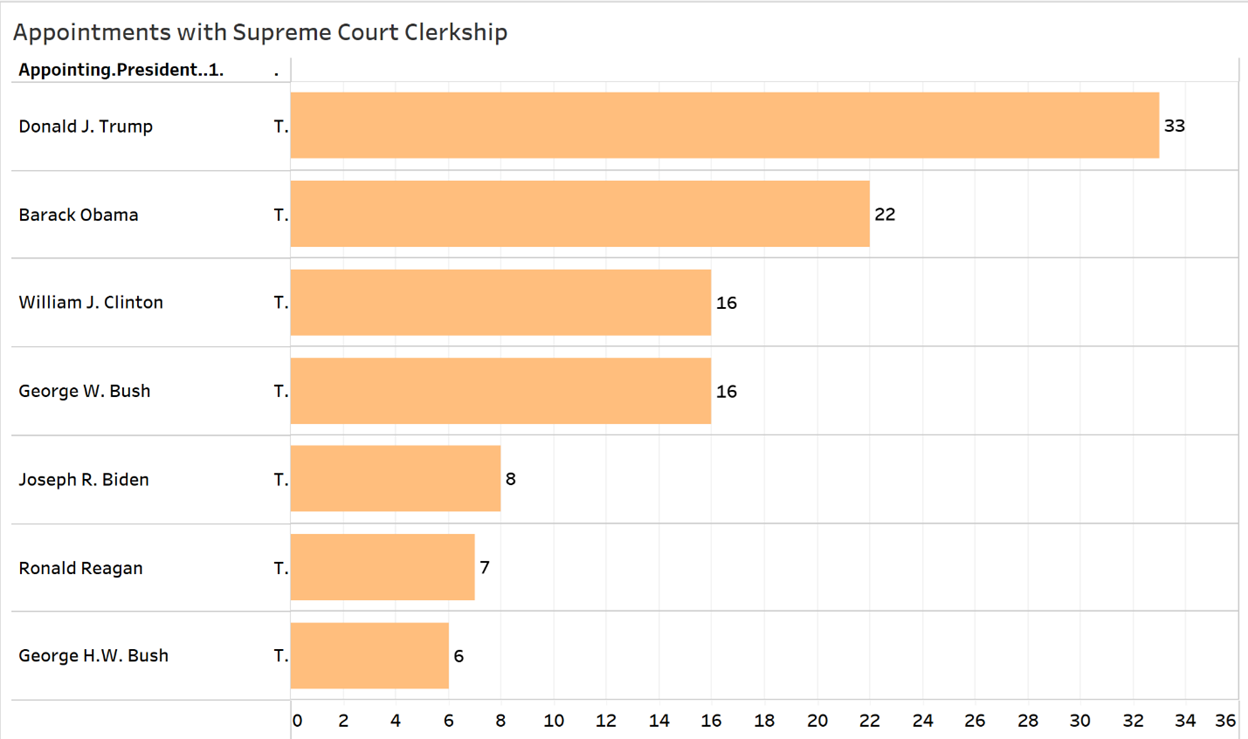

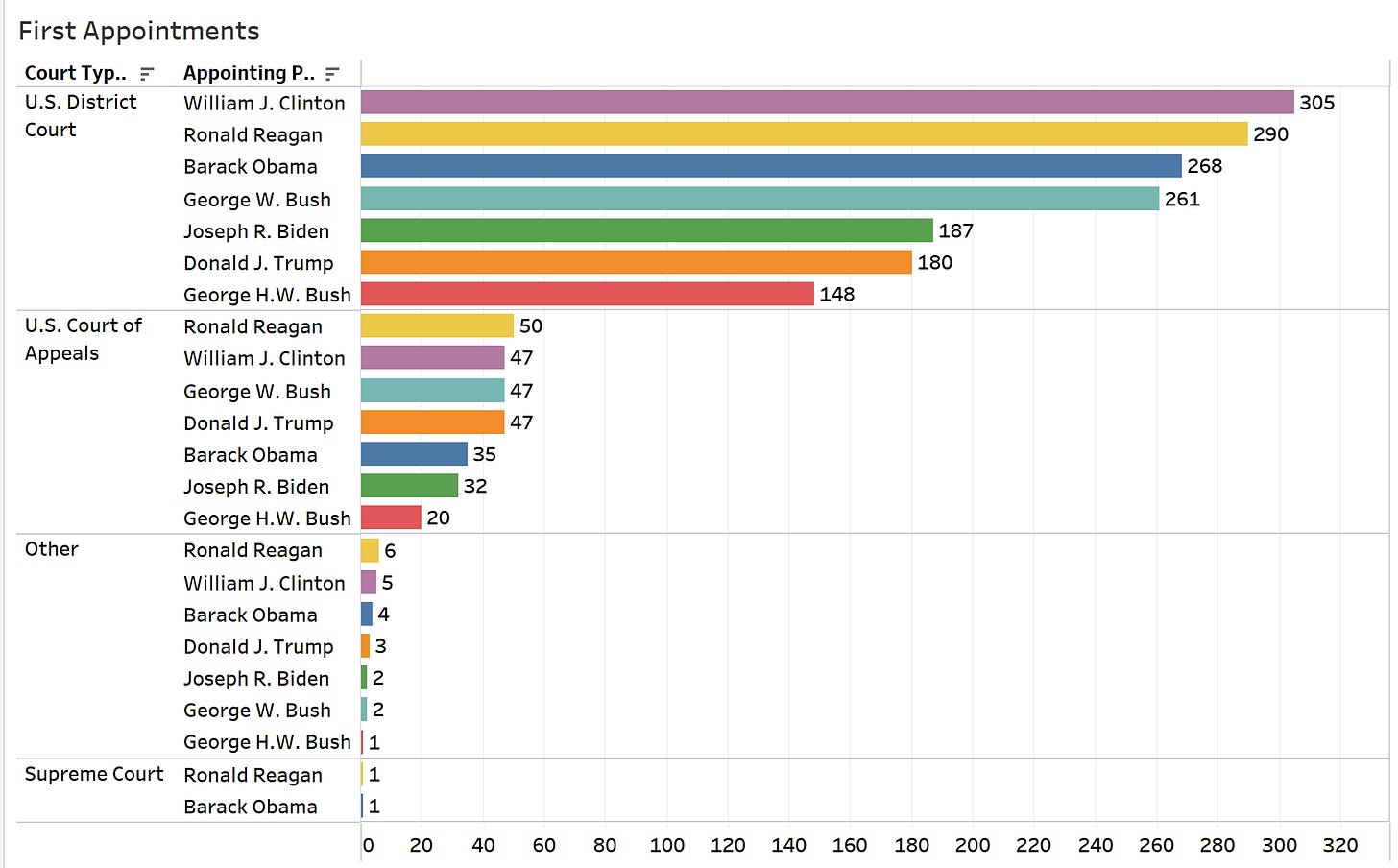
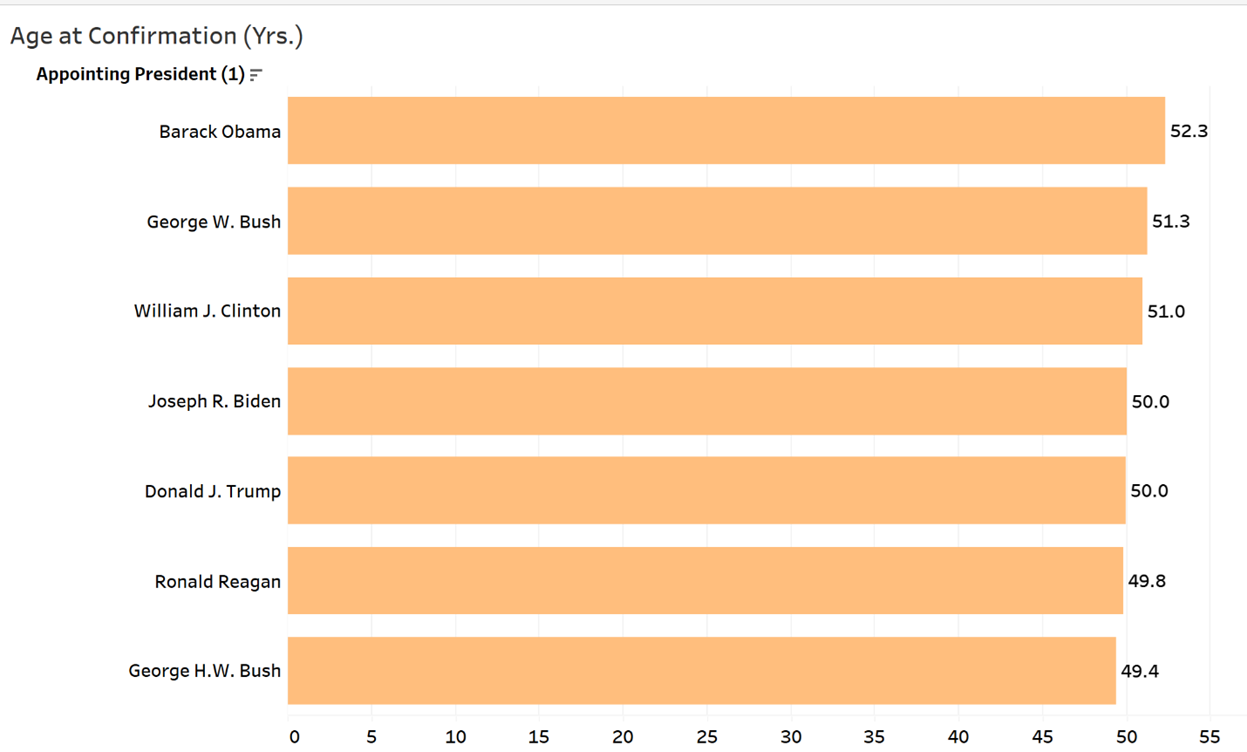
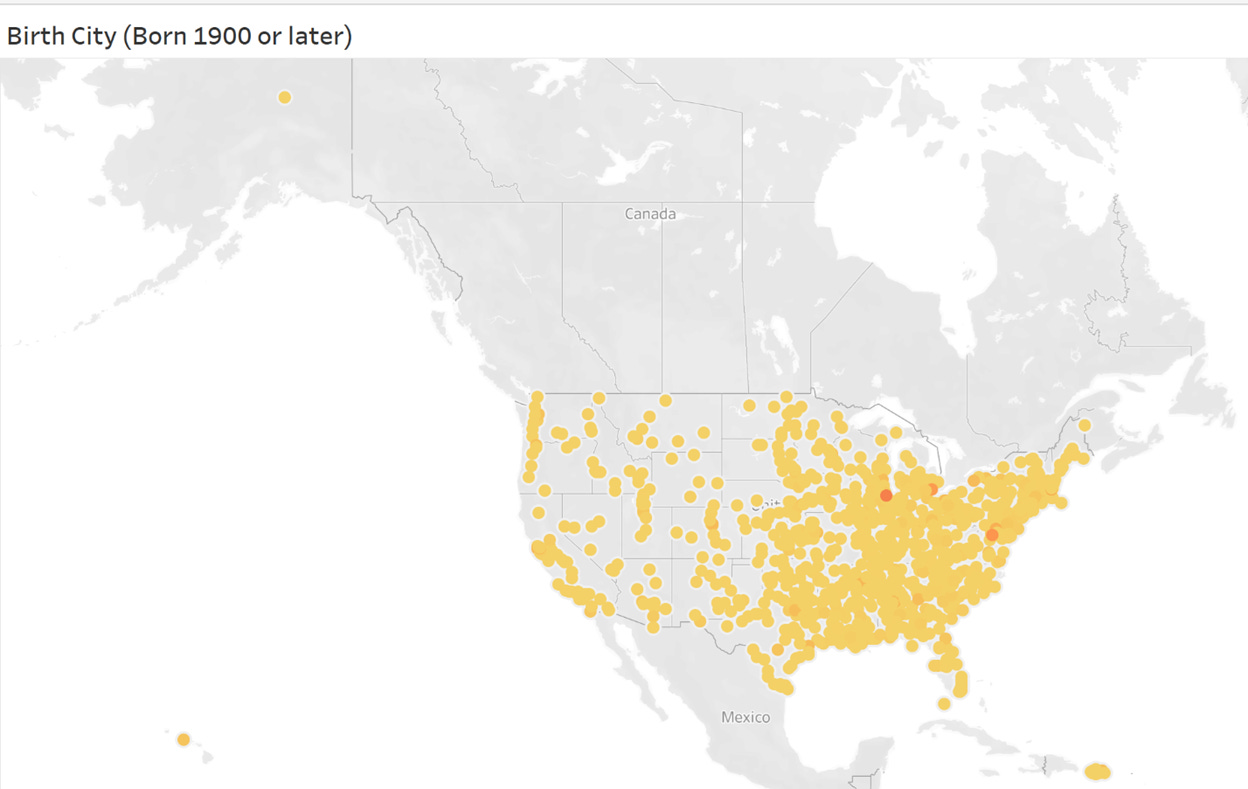
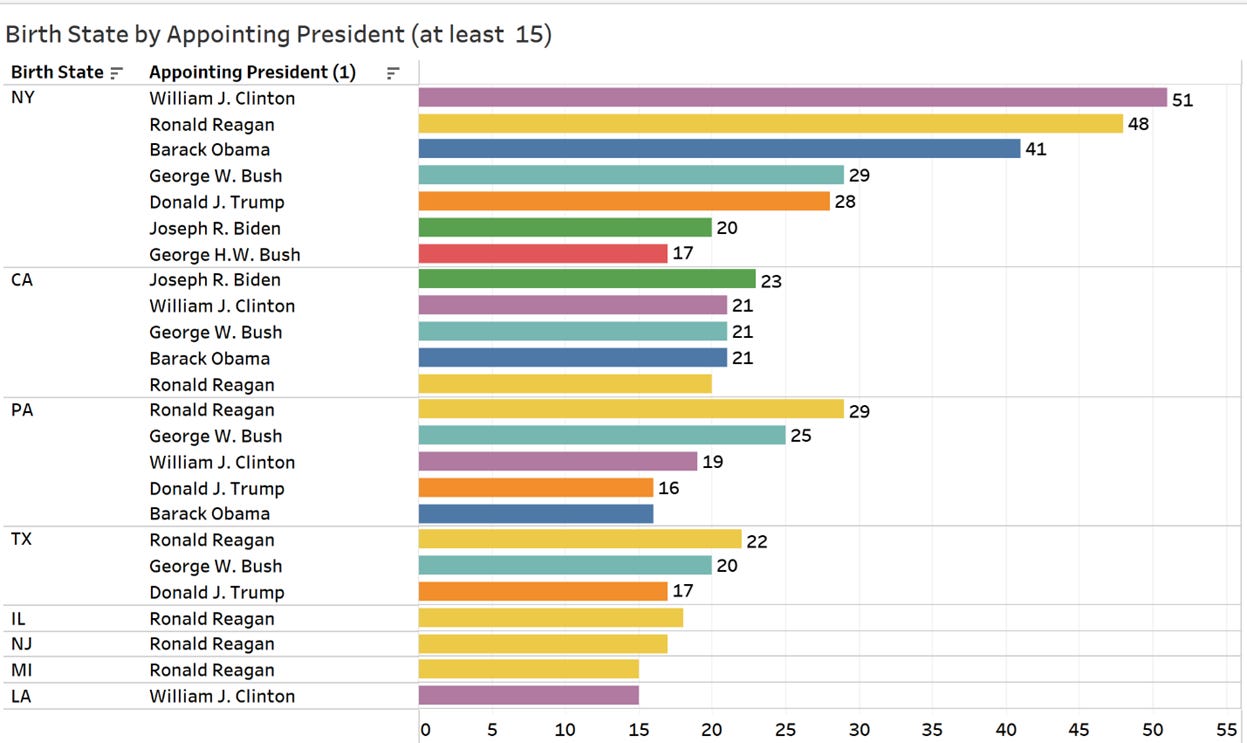


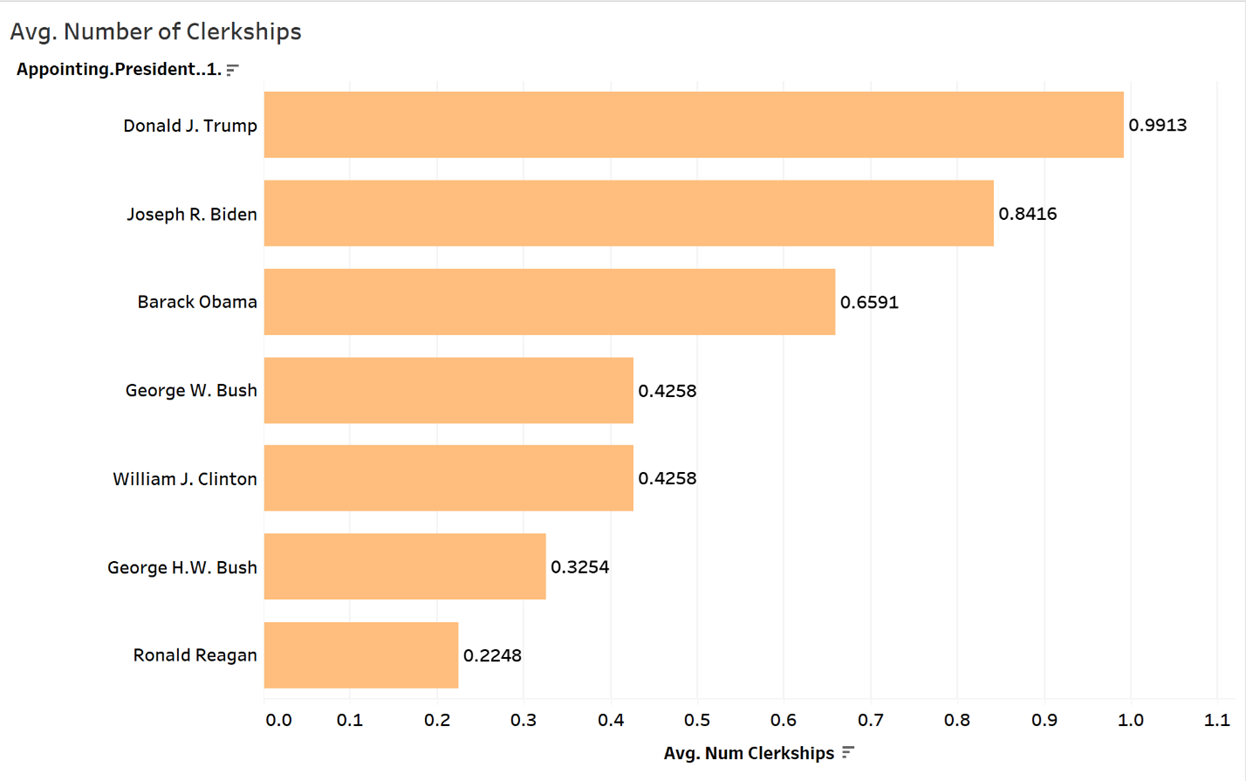
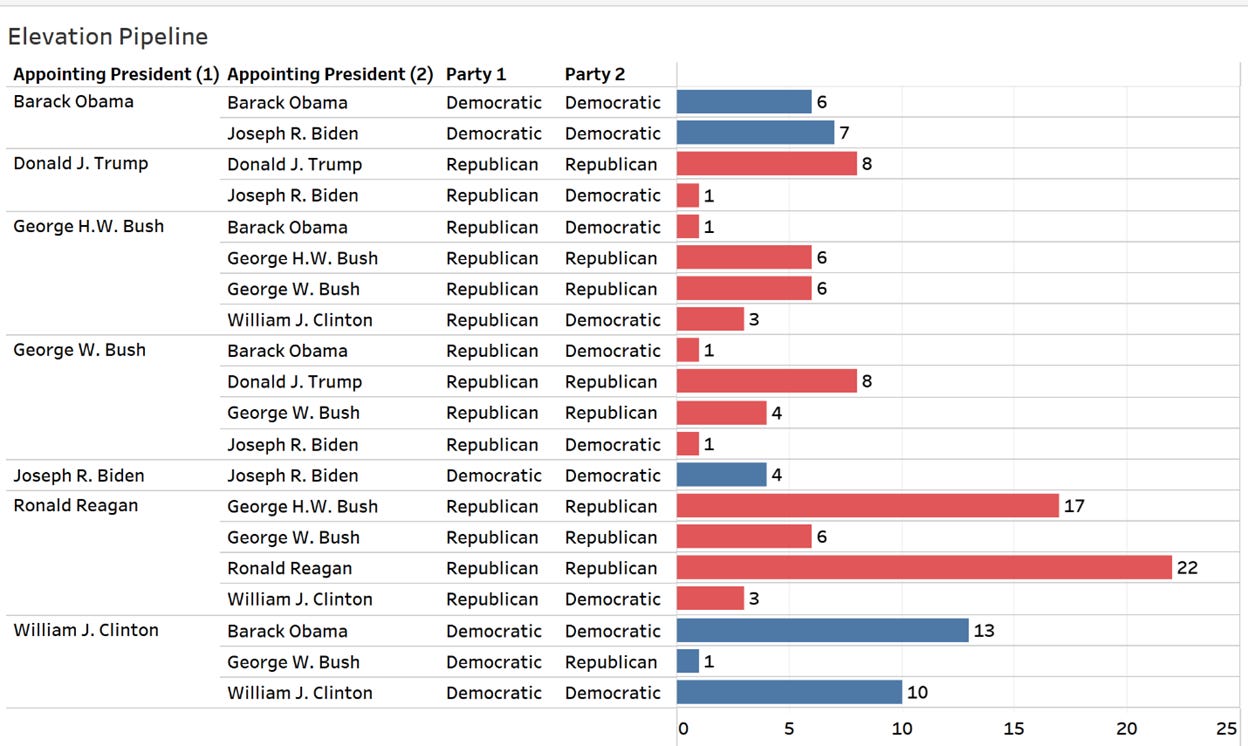



Another fascinating journey! It would be interesting to know exactly who is doing the legwork behind these nominations. I can’t see Trump or Reagan or George W. at all involved in the vetting. Heritage Foundation? Federalist Society? Dart board?